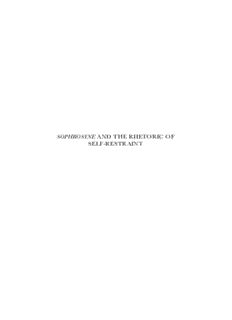
Sophrosyne And The Rhetoric Of Self-Restraint: Polysemy & Persuasive Use Of An Ancient Greek Value Term (Mnemosyne, Bibliotheca Classica Batava Supplementum) PDF
Preview Sophrosyne And The Rhetoric Of Self-Restraint: Polysemy & Persuasive Use Of An Ancient Greek Value Term (Mnemosyne, Bibliotheca Classica Batava Supplementum)
SOPHROSYNE AND THE RHETORIC OF SELF-RESTRAINT MNEMOSYNE BIBLIOTHECA CLASSICA BATAVA COLLEGERUNT H. PINKSTER •H.S. VERSNEL I.J.F. DE JONG •P.H. SCHRIJVERS BIBLIOTHECAE FASCICULOS EDENDOS CURAVIT H. PINKSTER, KLASSIEK SEMINARIUM, SPUISTRAAT 134, AMSTERDAM SUPPLEMENTUM DUCENTESIMUM QUINQUAGESIMUM NONUM ADRIAAN RADEMAKER SOPHROSYNE AND THE RHETORIC OF SELF-RESTRAINT SOPHROSYNE AND THE RHETORIC OF SELF-RESTRAINT POLYSEMY & PERSUASIVE USE OF AN ANCIENT GREEK VALUE TERM BY ADRIAAN RADEMAKER BRILL LEIDEN•BOSTON 2005 This book is printed on acid-free paper. Library of Congress Cataloging-in-Publication Data A C.I.P. record for this book is available from the Library of Congress. ISSN 0169-8958 ISBN 90 04 14251 7 © Copyright 2005 by Koninklijke Brill NV, Leiden, The Netherlands Koninklijke Brill NV incorporates the imprints Brill Academic Publishers, Martinus Nijhoff Publishers and VSP. All rights reserved. No part of this publication may be reproduced, translated, stored in a retrieval system, or transmitted in any form or by any means, electronic, mechanical, photocopying, recording or otherwise, without prior written permission from the publisher. Authorization to photocopy items for internal or personal use is granted by Brill provided that the appropriate fees are paid directly to The Copyright Clearance Center, 222 Rosewood Drive, Suite 910 Danvers, MA 01923, USA. Fees are subject to change. printed in the netherlands To the memory of Professor Dr C.M.J. Sicking in gratitude for his teaching CONTENTS Preface............................................................................................. xi Chapter One Introduction...................................................... 1 1. Aims of the Investigation:(cid:2)!vfro!Ênhin Plato and in non-philosophical Greek....................................... 1 2. The Meanings of !vfro!Ênh: An Overview provided by Plato’s Charmides............................................ 3 3. Problems with Traditional Semantic Descriptions of !vfro!Ênh................................................. 7 4. Contrasting Theories of Language and Meaning: Structuralist versus Cognitive Approaches...................... 14 5. Contrasting Conceptions of Categorisation: The ‘Classical Approach’ versus Cognitive Linguistics.. 19 6. Requirements for a Semantic Description of!≈frvnand Cognates.................................................... 26 7. Theoretical Apparatus for Addressing these Requirements............................................................ 30 8. The Disposition of this Study: Theory Versus Practice.. 35 Chapter Two Homer................................................................ 41 1. Introduction......................................................................... 41 2. %aofro!Ênhand the Rationalisation of Restraint in Homer.............................................................................. 42 3. Restraint and Concern for Others: Afid≈!....................... 50 4. Loss or Destruction of fr°ne!: the Critique of Unaccountable Behaviour...................... 54 5. Models of Good Sense and Control: Penelope, Telemachus and Odysseus.............................. 61 5.1. Penelope....................................................................... 62 5.2. Telemachus.................................................................. 68 5.3. Odysseus........................................................................ 70 6. Conclusion............................................................................ 74 viii CONTENTS Chapter Three Archaic Poetry................................................... 75 1. Introduction:!vfro!Ênhand the Male Citizen.............. 75 2. Political Uses of !vfro!Ênh: Theognidea, Pindar, Bacchylides........................................................................... 76 3. !vfro!Ênhin Private Life................................................... 92 4. Conclusion............................................................................ 97 Chapter Four Aeschylus............................................................ 99 1. Introduction......................................................................... 99 2. Restraint of Violence and Respect for the Gods: Seven Against Thebes, Oresteia....................................... 102 3. Quiet Behaviour and Control of Emotion: Seven Against Thebes, Suppliant Women....................... 113 4. Subjects and Authorities: Obedience............................... 117 5. Conclusion............................................................................ 120 Chapter Five Sophocles........................................................... 123 1. Introduction......................................................................... 123 2. Ajax........................................................................................ 125 3. Electra..................................................................................... 133 4. The ‘Prudential’ !vfro!Ênhof the Non-Heroic Citizen 137 5. Conclusion............................................................................ 141 Chapter Six Euripides............................................................ 143 1. Introduction......................................................................... 143 2. The Use of !≈frvnand Cognates in Euripides: Men... 145 3. The Use of !≈frvnand Cognates in Euripides: Women.................................................................................. 153 4. Different Views on !vfro!Ênh: The Farmer in Electra... 161 5. Hippolytus.............................................................................. 163 6. Bacchae................................................................................... 173 7. Medea..................................................................................... 182 8. Conclusion............................................................................ 188 Chapter Seven Historiography.................................................. 191 1. Introduction......................................................................... 191 2. Herodotus............................................................................. 194 3. Thucydides........................................................................... 201 3.1. !vfro!Ênhin External and Internal Politics........... 203 CONTENTS ix 3.2. !vfro!Ênhin Sparta.................................................... 208 3.3. !vfro!Ênhas a Political Slogan in Athens............... 216 3.4. The Chapter on !tã!i!................................................ 218 3.5. Conclusion.................................................................... 221 Chapter Eight Aristophanes and the Orators........................ 223 1. Introduction......................................................................... 223 2. Aristophanes: The !vfro!Ênhof the Ordinary Citizen 225 3. The Attic Orators: the !≈frvn pol¤th!........................... 233 4. The!vfro!Ênhof the pÒli!............................................... 247 5. Conclusion............................................................................ 249 Chapter Nine Preliminary Conclusions: The Meaning of !vfro!Ênhin Plato’s Time: A Synchronic Description............ 251 1. Introduction......................................................................... 251 2. The Uses of !≈frvnand Cognates in Plato’s Time: A Synchronic Conspectus................................................... 252 3. Turning Our Data into a ‘Network’: Parameters and Some Legenda........................................ 270 3.1. The Central Parameters: Who is !≈frvnand What are the Manifestations of !vfro!Ênh............. 270 3.2. Individual Perspectives: Which Speakers Insist on!vfro!Ênh?.............................................................. 271 3.3. Physical Manifestations of !vfro!Ênh...................... 272 3.4. The Connections between the Groups of Uses: The Synchronic Conspectus and Individual Authors: The Abstract Schemata... 274 4. The Specialised/Restricted Use of Some Cognate Terms: A Note on !vfrÒnv!, !vfron¤zein, !vfroni!tÆ! and!vfrÒni!ma...................... 288 5. An Outlook: Towards Plato............................................... 291 Chapter Ten Plato.................................................................... 293 1. Introduction......................................................................... 293 2. Polysemous!vfro!Ênh and the ‘Unity’ of Virtue.......... 295 3. !vfro!Ênh, !of¤a anddikaio!Ênh:Protagoras................... 299 4. !vfro!Ênh and éndre¤a:Laches.......................................... 305 5. !vfro!Ênhandéndre¤a:Gorgias......................................... 310 6. !vfro!Ênhandéndre¤a:RepublicandPoliticus................. 317 x CONTENTS 7. Polysemous!vfro!Ênh and the ‘Unity’ of Virtue: Conclusion............................................................................ 322 8. The Definition of !vfro!Ênh:Charmides.......................... 323 8.1. The First Definition: ≤!ux¤a....................................... 326 8.2. The Second Definition: afid≈!................................... 329 8.3. The Third Definition: tå •autoË prãttein.............. 330 8.4. The Fourth Definition: Self-Knowledge.................. 332 8.5. Charmides: Conclusions............................................... 339 9. The Definition of !vfro!Ênh:Republic............................. 341 10.Plato and !vfro!Ênh: Conclusions................................... 349 References....................................................................................... 357 General Index................................................................................. 367 Index of Greek Terms................................................................... 369 Selective Index of Works and Passages....................................... 371
Description: